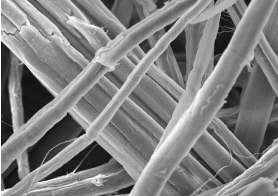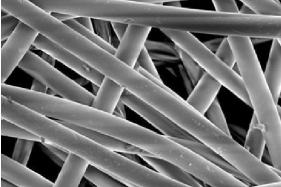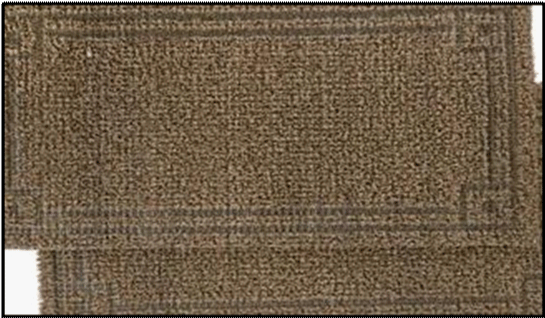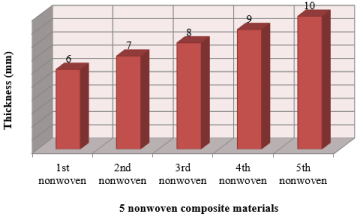
Research Article
Adv Res Text Eng. 2019; 4(2): 1039.
Investigation of the Mechanical Properties of Thermal Bonded Nonwoven Composite Produced of Blends with Sustainable Fibers
Shariful Islam1* and Shaharia Ahmed2
¹Department of Textile Engineering, Faculty of Science and Engineering, City University, Dhaka, Bangladesh
²SGS Bangladesh Limited, Dhaka, Bangladesh
*Corresponding author: Shariful Islam, Department of Textile Engineering, Faculty of Science and Engineering, City University, Dhaka, Bangladesh, Email: Sharifultextiles@gmail.com
Received: April 01, 2019; Accepted: August 07, 2019; Published: August 14, 2019
Abstract
The aim of this research is to investigate the mechanical properties of thermal bonded nonwoven composite materials produced of blend with sustainable fibers. Sustainable natural fibers like jute were used in this research with manmade polypropylene fibers at 50:50 ratios to confirm the blend ecofriendly. Thermal molding technique was applied to make the nonwoven composite by hot pressing. Nonwoven materials of different thickness were produced and scan images were taken with the help of scanning electron microscope instrument. The composite materials manufactured with these two fibers were cheaper, stronger and lighter, which were used in the interior part of the complex. The experiments were carried out in the textile laboratory at the temperature of 20±2°C with the relative humidity of 65±2%. Weight test of the nonwoven composite materials was carried out in accordance with the test method provided by ASTM D 3776 standard, tear strength was conducted in accordance with the test method provided by ASTM D 5734 standard, tensile strength was conducted in accordance with the test method provided by ASTM D 5034 standard and thickness test of the nonwoven was measured in accordance with the test method provided by DIN EN ISO 5084 standard. This research was practiced based and the findings were beneficial to the textile professionals who were responsible for the manufacturing of nonwoven composite textile materials produced of blends with sustainable fibers and to controlling of their mechanical properties.
Keywords: Nonwoven Composite; Mechanical Property; Thermal Conductivity; Compression; Molding; Elongation; Sustainable
Introduction
Different scholars worked related to this experiment at different times where literature review exposed different results. Some of which were similar and some were widely dissimilar. Due to the range of variables involved, if one parameter was changed then the other properties of the fabrics were also changed.
Shariful et.al, experimented the physical and acoustic properties of needle punched nonwoven that was produced of blends with sustainable fibers. They proved that sustainable natural fibers are harmless to the environment and they can be used inside the automobiles to reduce noise pollution [1].
Chen et.al, reported that nonwoven fabrics are made up with staple fibers or filaments by bonding together with thermal, mechanical, chemical, heat or adhesive manufacturing process. These nonwoven fabrics are produced for the purpose of comfort properties [2].
Yang et.al, reported that nonwoven fabrics are manufactured for the purpose of relaxation properties rather than its other mechanical properties like elongation, elasticity, durability, thermal conductivity, air permeability etc [3].
Suvari et.al, also reported that nonwoven fabrics are manufactured by bonding together with entangling the fibers or filaments by the process of thermo mechanical, physiochemical or by the process of adhesion [4].
Yang et.al, explained that nonwoven fabrics are like porous sheets those are made up with either by separate fibers or by plastic films [5]. The amount of recycled fabrics varied from process to process for the purpose of specific use [6].
Lin et.al, also proved that nonwoven fabrics are not produced weaving or knitting; rather they are made up with the assembling of fibers or filaments to make a liner surface that can be used as like a fabric for industrial or personal purpose [7].
Pasayev et.al, also reported that a number of recycled fabrics are used in nonwoven fabrics for the purpose of clothing, decoration, industrial application, commercial purpose etc. Likewise, these nonwoven fabrics can be reprocessed after use by giving proper treatment [8]. Because of this reason, a number of people consider the nonwoven fabrics as an ecological fabric for specific applications, particularly in the sanitation area where the disposable of products are imperative like as clinics, seminaries, conservations, safeguarding, nursing homes, luxury housings etc [9].
Thilagavathi et.al, also experimented that the nonwoven fabrics are engineered fabrics those are prepared for multipurpose like medical, aesthetic, acoustic, medical, comfort, health and hygiene etc [10]. Nonwoven fabrics used in medical sectors are manufactured by considering the health issues [11].
Nam et.al, also experimented that nonwoven fabrics have multi functions as like porosity, permeability, flexibility, elasticity, stretch, smoothness, durability, fire retardant, wash ability, moderating, heat protection, audio insulation, purification etc use as a bacteriological barricade and infertility [12].
Kakonke et.al, reported that the properties of nonwoven fabrics are habitually shared to make it applicable for specific jobs. They can satirist the entrance, texture, constancy, durability etc [13]. Strength of woven fabrics depend on the polyester fiber content and also the thickness of fabric [14]. In amalgamation with other constituents they supply a scale of products with varied possessions, and are used unaccompanied or as apparatuses of clothing, home fittings, fitness care, manufacturing, trade and customer properties [15].
Karaszewska et.al, reported that nonwovens are characteristically manufactured by placing staple fibers or filaments together in the form of a web, with binding them either mechanically or with an adhesive to melt the binder into the web by raising temperature [16].
Muthukumar et.al, reported that nonwovens have both the properties like softness and durability that depends upon the fibers it contains [17]. Nonwoven fabrics have the property like penetrability, resistance, elasticity, smoothness etc [18].
Thilagavathi et.al, also reported that nonwoven fabrics are produced by heat condition where fibers lead to curl up, and the scales fastening together that prevents the fibers from uncurling [19]. While washing a natural wool jumper it shrinks as much as it can due to its shrinkage properties [20].
Souza et.al, produced a fabric where, warp way jute yarn and weft way polypropylene yarn was used to make the woven cloth. Then composite was made up with thermal molding process and their mechanical properties were examined [21].
Shariful et.al, experimented the relationship in between strength and polyester content percentage of cotton polyester blended woven fabrics. They proved that the advantages of blending the fiber content were like blending of individual characteristics of each fibers to get some constant features in the blended fabrics [22].
Materials and Methods
Materials used
Nonwoven composite made up of natural jute and manmade polypropylene fibers were used in this research as mentioned in Table 1. Figure 1 shows the SEM figure of jute fibers and Figure 2 shows the SEM figure of polypropylene fibers. The composite was made up with 50% jute fibers and 50% polypropylene fibers and its mechanical properties were investigated. The nonwoven composite was made up with thermal molding and hot pressing system. 4 to 5 layers of woven cloths were taken to form molded nonwoven composite materials. The thickness of the nonwoven was from 6mm to 10mm and the per unit weight of the composite was from 524 g/m2 to 581 g/m2
S.N
Composition
Type
Manufacturing process
Thickness (mm)
Weight (g/m2)
1
.
.
50% Jute and 50% Polypropylene
.
.
Nonwoven
.
.
Molding and hot pressing
6
524
2
7
537
3
8
552
4
9
566
5
10
581
Table 1: Nonwoven composite used in this research.

Figure 1: Scanning Electron Microscopic View of jute fibers.

Figure 2: Scanning Electron Microscopic View of polypropylene fibers.
Method used
The experiments were carried out in accordance with the test method stated in this paper. Testing of the nonwoven composite was conducted in the textile laboratory at the temperature of 20±2°C and at the relative humidity of 65±2%.
Thickness test
Thickness test of the nonwoven was carried out in agreement with the test method provided by DIN EN ISO 5084 standard.
Weight test
Weight test of the nonwoven composite was carried out in accordance with the test method provided by ASTM D 3776 standard.
Tear strength
Tear strength of the nonwoven composite was conducted in accordance with the test method provided by ASTM D 5734 standard.
Tensile strength
Tensile strength of the nonwoven composite was conducted in accordance with the test method provided by ASTM D5034 standard.
Equipment Used
Thickness testing equipment
Digital Thickness Gauge “J-40-T-25MM” was used to measure the thickness of the nonwoven composite textile materials.
Weight testing equipment
Weight (g/m2) of the nonwoven composite materials was measured by “Testex Circular Sample Cutter TF513A/C/D”.
Tear testing equipment
Tear strength of the nonwoven composite materials was conducted with “Elmendorf Tear Strength” instrument.
Tensile testing equipment
Tensile strength of the nonwoven composite materials was conducted with “Titan 10 Universal Strength Tester” instrument.
Machine Used
Rucks Maschinenbau GmbH
Rucks Maschinenbau GmbH machine was used for continuous compression of molding system designed for lower-cost manufacturing of composites materials. This machine enabled higher pressing forces and higher temperatures that ranging from 250°C to 550°C.
Nonwoven manufacturing process
pWarp way jute and weft way polypropylene yarn was used to make woven fabric by hand loom. 4 to 5 woven fabrics were combined with thermal process to make the composite fabric. Jute/PP was a flat linear composite that was manufactured with molding process. 4 to 5 layers of jute/PP woven fabrics were combined and staked in a flat metal mold. For making uniform composite, split PP fibers were implanted between the layers of two fabrics of jute/PP. The metal flat mold was supplied with a power driven heating system as a thermal atmosphere and to process the laminating, where a hydraulic pressing system was used to pressurize to form the composite. Temperature was raised up to 550°C by this machine depending upon the thickness and nature of the composite. Figure 3 shows the woven fabric made up with hand loom where jute was given as warp yarn and polypropylene was given as weft yarn. Figure 4 shows the jute polypropylene nonwoven composite materials.

Figure 3: Woven fabric was made by jute (warp) yarn and polypropylene
(weft) yarn.

Figure 4: Jute polypropylene composite plate produced by molding with hot
pressing.
The Experiment
The required experiments were carried out in accordance with the test method mentioned in this paper. Samples were prepared as specified by the standard to carry out the required tests.
Experiment of thickness
Digital Thickness Gauge “J-40-T-25MM” was used to measure the thickness of the nonwoven textile materials in accordance with the test method provided by DIN EN ISO 5084 standard. Thickness of a material was defined as the distance between the upper surface and lower surface of the substance under a specific atmospheric condition. The tested sample was placed inside the instrument and then the button started to rotate until it touches the upper and lower surface of the tested materials. The thickness values were shown in the analog meter and the report was taken into note.
Experiment of weight
Weight (g/m2) of the nonwoven composite materials was tested by “Testex Circular Sample Cutter TF513A/C/D” in accordance with the test method provided by ASTM D 3776 Standard. A nonwoven material was taken after cutting by the machine and then it was measured with an electric scale to check the weight (g/m2) of the nonwoven materials.
Experiment of tear strength
Elmendorf Tear Tester was used to conduct the tearing strength of the composite materials. It had a pendulum pivoted on ball bearings at a perpendicular point with rigid metallic base. The pendulum was raised up to a definite height for the purpose of tearing the specimen. When the pendulum was released it achieved a potential energy due to which the pendulum tore the specimen and the pendulum lost the energy that was used to tear the specimen. Sample of rectangular size like “63mm × 76mm” was cut and prepared for testing the tear strength of the specimen. 5 specimens were cut from the composite materials in the machine direction and 5 samples were cut in the crosswise direction. A sample was placed with the tester to clamp in proper place. A cutting blade was used to cut a split in the composite from the edge of the specimen. The pendulum was released to circulate the split through the specimen. The force was required to tear the nonwoven composite materials.
Experiment of tensile strength
The tensile strength of the specimen was measured in agreement with the test method provided by ASTM D 5034 standard by “Instron 4411 Tensile Testing Machine” according to strip method. 5 composite specimens were taken at machine direction and 5 composite specimens were taken at perpendicular direction by cutting at the size of “50mm 175mm” with conditioning at humidity of 65±2% and temperature of 20±2°C. The distance among the fittings was adjusted to 75mm with the processing speed of 300mm per minute. One side of the tested sample was clamped at the upper jaw of the machine and another side of the tested sample was clamped at the lower jaw of the machine. The machine was operated with the foot pedal that was driven by hydraulic mandible. When foot pedal was pressed the upper part of the jaw started to move until the tested sample started to break for getting the tensile strength.
Result and Discussion
Mechanical properties of the nonwoven composite materials produced of blend with sustainable fibers were tested and their results were shown below.
Result of thickness
Five nonwoven composite materials were manufactured and Figure 5 showed the thickness of the nonwoven composite materials. It was seen from the figure that, the 1st nonwoven composite materials had the thickness of 6mm, the 2nd nonwoven composite materials had the thickness of 7mm, the 3rd nonwoven composite materials had the thickness of 8mm, the 4th nonwoven composite materials had the thickness of 9mm, the 5th nonwoven composite materials had the thickness of 10mm. It was seen from the figure that, the thickness of the nonwoven composite materials was increased with the increase of the number of the nonwoven.

Figure 5: Thickness of the nonwoven composite materials of 5 different
types.
Result of weight
Figure 6 showed the weight (g/m2) of the nonwoven composite materials of different thickness. It was seen from the figure that, 6mm thick nonwoven composite materials exposed the weight values of 524 g/m2. 7mm thick nonwoven composite materials exposed the weight values of 537 g/m2, 8mm thick nonwoven composite materials exposed the weight values of 552 g/m2, 9mm thick nonwoven composite materials exposed the weight values of 566 g/m2 and 10mm thick nonwoven composite materials exposed the weight values of 581 g/m2. It was seen from the figure that, the weight (g/m2) values of the nonwoven composite materials was increased with the increase of the thickness of the nonwoven.

Figure 6: Weight (g/m2) of the nonwoven composite materials of different
thickness.
Result of tear strength
Figure 7 showed the tear strength of the nonwoven composite materials of different thickness. It was seen from the figure that, 6mm thick nonwoven composite materials exposed the tear strength of 16.27 kg. 7mm thick nonwoven composite materials exposed the tear strength of 20.24 kg. 8mm thick nonwoven composite materials exposed the tear strength of 22.38 kg. 9mm thick nonwoven composite materials exposed the tear strength of 25.46 kg and 10mm thick nonwoven composite materials exposed the tear strength of 28.68 kg. It was seen from the figure that, the tear strength of the nonwoven composite materials was increased with the increase of the thickness of the nonwoven.

Figure 7: Tear strength of the nonwoven composite materials of different
thickness.
Discussion
It was seen from the Figure 5 that 5 nonwoven composite materials were manufactured of different thickness (mm). First nonwoven composite materials were thin but subsequent composites were heavier. The sequence for thickness was given to investigate the different mechanical properties of the composites. It was seen from the Figure 6 that different weight (g/m2) values were obtained for the different thickness of the composite materials. The more the thickness values were the more the weight values were. It was seen from the Figure 7 that different tear strength values were obtained for the different thickness of the composite materials. The more the thickness values were the more the tear strength were. It was also seen from the Figure 8 that different tensile strength values were obtained for the different thickness of the composite materials. The more the thickness values were the more the tensile strength were.

Figure 8: Tensile strength of the nonwoven composite materials of different
thickness.
Conclusion
It was seen throughout the research that the mechanical properties of the nonwoven composite materials were related with the thickness values of textile composite materials. The mechanical properties like tear and tensile strength were increased with the increase of the thickness of the nonwoven composite materials. It was also seen that the weight values were directly proportional to the thickness of the materials. The importance for manufacturing the nonwoven composite materials with natural jute fibers was to increase the sustainability. Manmade polypropylene fibers were not recyclable besides, the composites manufactured with these fibers were not sustainable but jute fibers were friendly to the nature. These composites are lighter, stronger, cheaper and are used in the interior part of the complex. These composites can be tailored to meet necessities and are less noisy while in operation. Jute polypropylene composite is the construction but can be fabricated when required. The idea for blending of jute and polypropylene was to achieve the individual benefits of both these two fibers. This research was advantageous to the textile professionals and opened potential ways to further study in this field.
References
- Islam S, Mominul Alam SM. Investigation of the acoustic properties of needle punched nonwoven produced of blend with sustainable fibers. International Journal of Clothing Science and Technology. 2018; 2: 444-458.
- Chen HX, Liu X. Feng SJ, Chen JN, Zhang DM, Zhou A. Microscale investigation into mechanical behaviors of heat-bonded nonwoven geotextile using DEM. Geotextiles and Geomembranes. 2019; 3.
- Yang T, Xiong X, Venkataraman M, Mishra R, Novák J, Militký J. Investigation on sound absorption properties of aerogel/polymer nonwovens. The Journal of The Textile Institute. 2019; 2: 196-201.
- Suvari F, UlcayY, Pourdeyhimi B. Influence of sea polymer removal on sound absorption behavior of islands-in-the-sea spunbonded nonwovens. Textile Research Journal. 2019; 12: 2444-2455.
- Yang T. Xiong X, Mishra R, Novák J, Militký J. Sound absorption and compression properties of perpendicular-laid nonwovens. Textile Research Journal. 2019;4: 612-624.
- Wijeratne RS, De Vita R, Rittenhouse JA, Orler EB, Moore RB, Dillard DA. Biaxial properties of individual bonds in thermomechanically bonded nonwoven fabrics. Textile Research Journal. 2019; 5: 698-710.
- Lin MC, Lou CW, Lin JY, Lin TA, Lin JH. Mechanical property evaluations of flexible laminated composites reinforced by high-performance Kevlar filaments: Tensile strength, peel load, and static puncture resistance. Composites Part B: Engineering. 2019; 166: 139-147.
- Pasayev N, Kocatepe S, Maras N. Investigation of sound absorption properties of nonwoven webs produced from chicken feather fibers. Journal of Industrial Textiles. 2019; 10: 1616-1635.
- Gao T, Zhao SJ, Bao RY, Zhong GJ, Li ZM, etc. Constructing Sandwich- Architectured Poly (L-lactide)/High-Melting-Point Poly (L-lactide) Non-Woven Fabrics: Towards Heat Resistant Poly (L-lactide) Barrier Biocomposites with Full Biodegradability. ACS Applied Bio Materials. 2019;
- Thilagavathi G, Muthukumar N, Neela Krishnanan S, Senthilram T. Development and Characterization of Pineapple Fibre Nonwovens for Thermal and Sound Insulation Applications. Journal of Natural Fibers. 2019; 1-10.
- Zhao L, Huang Z, Xiong S, Peng J, Sun J, Yin X. Polyphenylene sulfide composite laminate from flexible nonwovens and carbon fiber fabrics prepared by thermal lamination and thermal treatment. Polymer Bulletin. 2016; 1-16.
- Nam C, Lee YA. 2019. Multilayered Cellulosic Material as a Leather Alternative in the Footwear Industry. Clothing and Textiles Research Journal. 2019; 1: 20-34.
- Kakonke G, Tesfaye T, Sithole B. Review on the Manufacturing and Properties of Nonwoven Superabsorbent Core Fabrics used in Disposable Diapers. Int J Chem Sci. 2019; 1: 302.
- Puchalski M, Siwek P, Panayotov N, Berova M, Kowalska S, Krucinska I. Influence of Various Climatic Conditions on the Structural Changes of Semicrystalline PLA Spun-Bonded Mulching Nonwovens during Outdoor Composting. Polymers. 2019; 3: 559.
- Wang H, Li N, Niu J, Teng K, Xu Z, Jing M, etc. Fiber-welded ciliated-like nonwoven fabric nano-composite multiscale architectures for superior mechanical and electromagnetic shielding behaviors. Composites Part A: Applied Science and Manufacturing. 2019.
- Karaszewska A, Kaminska I, Nejman A, Gajdzicki B, Fortuniak W, Chojnowski J, etc. 2019. Thermal-regulation of nonwoven fabrics by microcapsules of n-eicosane coated with a polysiloxane elastomer. Materials Chemistry and Physics. 2019; 226: 204-213.
- Muthukumar N, Thilagavathi G, Neelakrishnan S, Poovaragan PT. Sound and thermal insulation properties of flax/low melt PET needle punched nonwovens. Journal of Natural Fibers. 2019;2: 245-252.
- Sheng J, Zhao J, Yu X, Liu L, Yu J, Ding B. Electrospun Nanofibers for Waterproof and Breathable Clothing. In Electrospinning: Nanofabrication and Applications. William Andrew Publishing. 2019; 543-570.
- Thilagavathi G, Muthukumar N, Neelakrishnan S, Egappan RS. Development of polyester needle-punched nonwoven fabrics for filter press applications. Journal of Industrial Textiles. 2019; 10: 566-1579.
- Rittenhouse J, Wijeratne R, Orler EB, Dillard DA, Moore RB, De Vita R. Effect of areal density and fiber orientation on the deformation of thermomechanical bonds in a nonwoven fabric. Polymer Engineering & Science. 2019; 2: 311- 322.
- Souza BR, Di Benedetto RM, Hirayama D, Raponi ODA, Barbosa LCM, Ancelotti Junior AC. Manufacturing and Characterization of Jute/PP Thermoplastic Commingled Composite. Materials Research. 2017; 20: 458- 465.
- Islam S, Ahmed S, Arifuzzaman M, Islam AS, Akter S. 2019. Relationship in between Strength and Polyester Content Percentage of Cotton Polyester Blended Woven Fabrics. International Journal of Clothing Science. 2019; 1: 1-6.